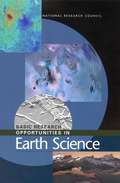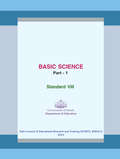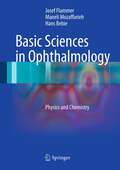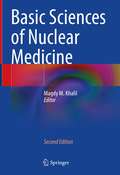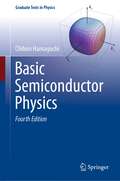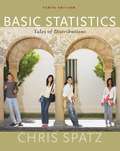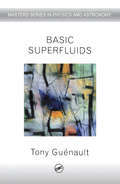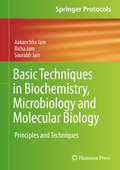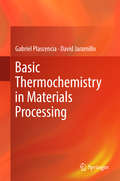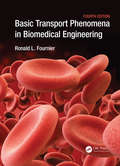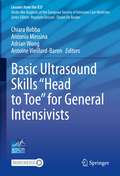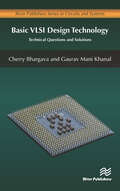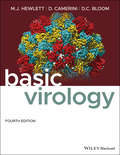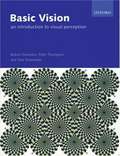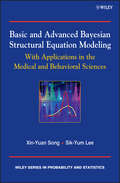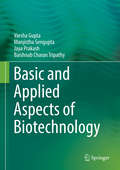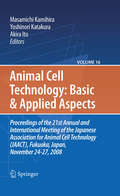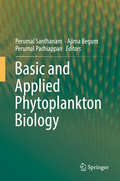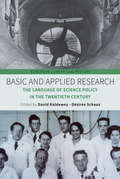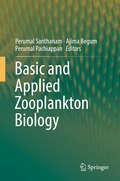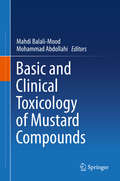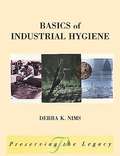- Table View
- List View
Basic Research Opportunities in Earth Science
by National Research CouncilThe Committee concludes that the National Science Foundation, through its Earth Science Division is the only federal agency that maintains significant funding for basic research in all the core disciplines of Earth science, and is therefore central to the discipline's national effort. Rather than reviewing existing Division programs, the report identifies new research areas that could be added to its solid-Earth and hydrology portfolio. It is not indexed. Annotation c. Book News, Inc. , Portland, OR (booknews. com)
Basic Science Part 1 class 5 - Kerala Board
by ScertBasic Science text book, class V, SCERT Kerala syllabus, english medium. It covers the chapters - Know the Plant World Closely, Life-Giving Water, Celestial Shadow Sights, Life within the Seed and Energy Sources.
Basic Science Part 1 class 8 - S.C.E.R.T. - Kerala Board
by State Council of Educational Research TrainingBasic Science Part 1 textbook for 8th standard from State Council of Educational Research and Training (S.C.E.R.T.) Kerala in English.
Basic Science Part 2 class 5 - Kerala Board
by ScertBasic Science text book, class V, SCERT Kerala syllabus, english medium. It covers the chapters - A Little Effort, Lot of Work, Windows of Knowledge, Keeping Diseases at Bay, Space - a World of Wonders and Animal Lore.
Basic Science Part 2 class 8 - S.C.E.R.T. - Kerala Board
by State Council of Educational Research and TrainingBasic Science Part 2 text book for 8th standard from State Council of Educational Research and Training (S.C.E.R.T.) Kerala in English.
Basic Sciences in Ophthalmology: Physics and Chemistry
by Hans Bebie Josef Flammer Maneli MozaffariehBasic Sciences in Ophthalmology aims to link clinical ophthalmology directly to its basic science roots. This first volume describes the physics and chemistry required for a sound understanding of modern ophthalmology. The book opens with an extensive discussion of the interaction of light with matter and the way in which light is used in ophthalmic examinations and treatments. After describing traditional methods of imaging, particular emphasis is placed on modern instrumentation such as OCT. The interaction between light and tissues in different types of laser treatment is also addressed. The chemistry section focuses on compounds particularly relevant to the eye, such as oxygen and water. The origin and consequences of oxidative stress are reviewed, and the physical behavior of chemical compounds in the eye is explained. Understanding is facilitated through the use of many examples taken from the field of ophthalmology. The text is complemented by about 450 figures.
Basic Sciences of Nuclear Medicine
by Magdy M. KhalilThis book provides comprehensive and detailed information on the scientific bases of nuclear medicine, addressing a wide variety of topics and explaining the concepts that underlie many of the investigations and procedures performed in the field. The book is divided into six sections that cover the physics and chemistry of nuclear medicine besides associated quality assurance/quality control procedures; dosimetry and radiation biology; SPECT and PET imaging instrumentation plus CT imaging technology in hybrid modalities; data analysis including image processing, reconstruction, radiomics, image degrading correction techniques, along with image quantitation and kinetic modeling. Within these sections, particular attention is paid to recent developments and the advances in knowledge that have taken place since release of the first edition in 2011. Several entirely new chapters have been included and the remaining chapters, thoroughly updated.Innovations in the ever-expanding field of nuclear medicine are predominantly due to integration of the basic sciences with complex technological advances. This excellently illustrated book on the subject will be of interest to not only nuclear medicine physicists and physicians but also clinical scientists, radiologists, radiopharmacists, medical students and technologists.
Basic Semiconductor Physics (Graduate Texts in Physics)
by Chihiro HamaguchiThis textbook presents a detailed description of basic semiconductor physics, covering a wide range of important phenomena in semiconductors, from simple to advanced. It introduces and explains four different methods of energy band calculations in the full band region and covers fundamental topics such as the effective mass approximation and electron motion in a periodic potential, the Boltzmann transport equation, and deformation potentials used for the analysis of transport properties. The text also examines experimental and theoretical analyses of cyclotron resonance in detail and reviews essential optical and transport properties, while covering optical transitions, electron–phonon interaction, and electron mobility. It presents numerical calculations of scattering rate, relaxation time, and mobility for typical semiconductors with bulk, quantum well and HEMT structures including wideband gap materials such as GaN and SiC in addition to IV and III-V semiconductors.The updated fourth edition includes coverage of new topics such as surface-modulated superlattices, Wannier–Stark effect, Bloch oscillation, wide band gap semiconductors, and photonic crystals. Featuring full-color diagrams calculated with updated physical parameters, as well as chapter-end problems and solutions, this tried and tested textbook on the basics of semiconductors physics is the cornerstone to any graduate or upper-level undergraduate course on the subject.
Basic Statistics: Tales Of Distributions
by Chris SpatzLearn statistical reasoning and problem solving from a best-selling author who uses a wealth of examples from the social and behavioral sciences,, education,, nursing/allied health, and business fields--as well as examples from everyday life-to help you learn and understand. Praised for his clear explanations, Spatz shows you how to start with a data set, identify the questions it poses, determine and carry out statistical procedures, and using plain English, tell the story the data reveal.
Basic Superfluids
by Tony GuenaultSuperfluidity is the jewel in the crown of low temperature physics. When temperatures are low enough, every substance in thermal equilibrium must become ordered. Since some materials remain fluid to the lowest temperatures, it is a fascinating question as to how this ordering can take place. One possibility is the formation of a superfluid state, a
Basic Techniques in Biochemistry, Microbiology and Molecular Biology: Principles and Techniques (Springer Protocols Handbooks)
by Aakanchha Jain Richa Jain Sourabh JainThis book presents key methodologies, tools and databases for biochemistry, microbiology and molecular biology in simple and straightforward language. Covering all aspects related to experimental principles and procedures, the protocols included here are brief and clearly defined, and include essential precautions to be taken while conducting experiments. The book is divided into two major sections: one on constructing, working with, and standard operating procedures for laboratory instruments; and one on practical procedures used in molecular biology, microbiology and biochemical analysis experiments, which are described in full. Each chapter describes both the basic theory and relevant practical details for a given experiment, and helps readers recognize both the experiment’s potential and limitations. Intended as an intensive introduction to the various tools used in molecular biology, the book covers all basic methods and equipment, including cloning, PCR, spectrophotometers, ELISA readers, sonicators, etc. As such, it offers a valuable asset for final year undergraduate (especially project) students, graduate research students, research scientists and technicians who wish to understand and employ new techniques in the field of biotechnology.
Basic Thermochemistry in Materials Processing
by David Jaramillo Gabriel PlascenciaThis book provides the reader with some thermochemistry notes. The intention is to provide a simple, easy to understand text which serves as a complimentary material to more complex books. It also provide students and those beginning in the field with several application examples used in different areas of materials processing. The book presents fully solved problems, some quite often found in major metallurgical operations.
Basic Transport Phenomena in Biomedical Engineering (Fourth Edition)
by Ronald L. FournierThis will be a substantial revision of a good selling text for upper division/first graduate courses in biomedical transport phenomena, offered in many departments of biomedical and chemical engineering. Each chapter will be updated accordingly, with new problems and examples incorporated where appropriate. A particular emphasis will be on new information related to tissue engineering and organ regeneration. A key new feature will be the inclusion of complete solutions within the body of the text, rather than in a separate solutions manual. Also, Matlab will be incorporated for the first time with this Fourth Edition.
Basic Ultrasound Skills “Head to Toe” for General Intensivists (Lessons from the ICU)
by Antoine Vieillard-Baron Chiara Robba Antonio Messina Adrian WongThe aim of this book, part of the European Society of Intensive Care Medicine (ESICM) textbook series, is to educate and train practitioners in the safe and competent use of diagnostic ultrasound imaging in the visualization and interpretation of different conditions. Specifically, the program will train practitioners in the safe and accurate acquisition of ultrasound images in the examination and monitoring of patients in intensive care settings. The readers will be able to obtain knowledge on the use of ultrasound in a safe and effective manner and to learn how ultrasound examination can be used to optimize clinical management of patients. The chapters include ultrasound physics, ultrasound examination technique, optimization of the image, bedside ultrasound diagnosis of different diseases. Different domains will be addressed from the evaluation of different organs such as the heart, the lung, the abdomen, vessels and brain, focusing on the basic skills required to an intensivists working in the general Intensive Care Unit settings. The book - richly illustrated and with electronic supplementary contributions - is intended for anaesthetists and intensivists with basic knowledge of ultrasound physics and practical experience of ultrasound.
Basic VLSI Design Technology: Technical Questions and Solutions (River Publishers Series In Circuits And Systems Ser.)
by Cherry Bhargava Gaurav Mani KhanalThe current cutting-edge VLSI circuit design technologies provide end-users with many applications, increased processing power and improved cost effectiveness. This trend is accelerating, with significant implications on future VLSI and systems design. VLSI design engineers are always in demand for front-end and back-end design applications.The book aims to give future and current VSLI design engineers a robust understanding of the underlying principles of the subject. It not only focuses on circuit design processes obeying VLSI rules but also on technological aspects of fabrication. The Hardware Description Language (HDL) Verilog is explained along with its modelling style. The book also covers CMOS design from the digital systems level to the circuit level. The book clearly explains fundamental principles and is a guide to good design practices.The book is intended as a reference book for senior undergraduate, first-year post graduate students, researchers as well as academicians in VLSI design, electronics & electrical engineering and materials science. The basics and applications of VLSI design from digital system design to IC fabrication and FPGA Prototyping are each covered in a comprehensive manner. At the end of each unit is a section with technical questions including solutions which will serve as an excellent teaching aid to all readers.Technical topics discussed in the book include: • Digital System Design• Design flow for IC fabrication and FPGA based prototyping • Verilog HDL• IC Fabrication Technology• CMOS VLSI Design• Miscellaneous (It covers basics of Electronics, and Reconfigurable computing, PLDs, Latest technology etc.).
Basic Virology
by Martinez J. Hewlett David Camerini David C. BloomThe foundational textbook on the study of virology Basic Virology, 4th Edition cements this series’ position as the leading introductory virology textbook in the world. It’s easily read style, outstanding figures, and comprehensive coverage of fundamental topics in virology all account for its immense popularity. This undergraduate-accessible book covers all the foundational topics in virology, including: The basics of virology Virological techniques Molecular biology Pathogenesis of human viral disease The 4th edition includes new information on the SARS, MERS and COVID-19 coronaviruses, hepatitis C virus, influenza virus, as well as HIV and Ebola. New virological techniques including bioinformatics and advances in viral therapies for human disease are also explored in-depth. The book also includes entirely new sections on metapneumoviruses, dengue virus, and the chikungunya virus.
Basic Vision: An Introduction to Visual Perception
by Peter Thompson Robert Snowden Tom TrosciankoBasic Vision: An Introduction to Visual Perception demystifies the processes through which the brain "sees." It leads us through the various elements that come together in our perception of the world around us: size, color, motion, and three-dimensional space. The book illustrates the intricacy of the visual system, discussing its development during infancy, and reveals how the brain can get it wrong.
Basic and Advanced Bayesian Structural Equation Modeling
by Xin-Yuan Song Sik-Yum LeeThis book provides clear instructions to researchers on how to apply Structural Equation Models (SEMs) for analyzing the inter relationships between observed and latent variables.Basic and Advanced Bayesian Structural Equation Modeling introduces basic and advanced SEMs for analyzing various kinds of complex data, such as ordered and unordered categorical data, multilevel data, mixture data, longitudinal data, highly non-normal data, as well as some of their combinations. In addition, Bayesian semiparametric SEMs to capture the true distribution of explanatory latent variables are introduced, whilst SEM with a nonparametric structural equation to assess unspecified functional relationships among latent variables are also explored.Statistical methodologies are developed using the Bayesian approach giving reliable results for small samples and allowing the use of prior information leading to better statistical results. Estimates of the parameters and model comparison statistics are obtained via powerful Markov Chain Monte Carlo methods in statistical computing.Introduces the Bayesian approach to SEMs, including discussion on the selection of prior distributions, and data augmentation.Demonstrates how to utilize the recent powerful tools in statistical computing including, but not limited to, the Gibbs sampler, the Metropolis-Hasting algorithm, and path sampling for producing various statistical results such as Bayesian estimates and Bayesian model comparison statistics in the analysis of basic and advanced SEMs.Discusses the Bayes factor, Deviance Information Criterion (DIC), and $L_\nu$-measure for Bayesian model comparison.Introduces a number of important generalizations of SEMs, including multilevel and mixture SEMs, latent curve models and longitudinal SEMs, semiparametric SEMs and those with various types of discrete data, and nonparametric structural equations.Illustrates how to use the freely available software WinBUGS to produce the results.Provides numerous real examples for illustrating the theoretical concepts and computational procedures that are presented throughout the book.Researchers and advanced level students in statistics, biostatistics, public health, business, education, psychology and social science will benefit from this book.
Basic and Applied Aspects of Biotechnology
by Varsha Gupta Manjistha Sengupta Jaya Prakash Baishnab Charan TripathyThis book explores the journey of biotechnology, searching for new avenues and noting the impressive accomplishments to date. It has harmonious blend of facts, applications and new ideas. Fast-paced biotechnologies are broadly applied and are being continuously explored in areas like the environmental, industrial, agricultural and medical sciences. The sequencing of the human genome has opened new therapeutic opportunities and enriched the field of medical biotechnology while analysis of biomolecules using proteomics and microarray technologies along with the simultaneous discovery and development of new modes of detection are paving the way for ever-faster and more reliable diagnostic methods. Life-saving bio-pharmaceuticals are being churned out at an amazing rate, and the unraveling of biological processes has facilitated drug designing and discovery processes. Advances in regenerative medical technologies (stem cell therapy, tissue engineering, and gene therapy) look extremely promising, transcending the limitations of all existing fields and opening new dimensions for characterizing and combating diseases.
Basic and Applied Aspects: Proceedings of the 21st Annual and International Meeting of the Japanese Association for Animal Cell Technology (JAACT), Fukuoka, Japan, November 24-27, 2008 (Animal Cell Technology: Basic & Applied Aspects #16)
by Masamichi Kamihira Akira Ito Yoshinori KatakuraAnimal cell technology is a growing discipline of cell biology which aims not only to understand the structure, function and behavior of differentiated animal cells, but also to ascertain their ability to be used for industrial and medical purposes. Some of the major goals of animal cell technology include: the clonal expansion of differentiated cells, the optimization of their culture conditions, modulation of their ability for the production of medically and pharmaceutically important proteins and the application of animal cells to gene therapy, artificial organs and functional foods. This volume gives the readers a complete review of the present state-of-the-art research in Japan and other countries where this field is well advanced. The Proceedings will be useful to cell biologists, biochemists, molecular biologists, immunologists, biochemical engineers and to those working in either academic environments or in the biotechnology and pharmacy industries related to animal cell culture.
Basic and Applied Phytoplankton Biology
by Perumal Pachiappan Perumal Santhanam Ajima BegumThis book presents the latest developments and recent research trends in the field of plankton, highlighting the potential ecological and biotechnological applications. It critically and comprehensively discusses strain selection, growth characteristics, large-scale culturing, and biomass harvesting, focusing on the screening and production of high-value products from algae, and evaluating carbon dioxide sequestration from fuel gas as a climate change mitigation strategy. The latter areas of research are clearly central to the sustainable development approach that is currently attracting global attention.Over the decades, much of the literature on has focused on the biological and ecological aspects of phytoplankton found in freshwater, marine and brackish water environments. However, these organisms are known to also inhabit various other environments. More recently, there has been a substantial shift toward the concept of sustainable development and the “green economy” with emphasis on exploiting biological systems for the benefit of mankind. The significance of these plankton cannot be underestimated as they contribute approximately 40% of the oxygen in the atmosphere. Therefore, there is potential for exploitation of this invaluable biomass source that could lead to significant environmental and economic benefits for man.Providing a comprehensive outline of the most recent developments and advances in the field of industrial applications of these plankton, this book is an excellent reference resource for researchers and practitioners.
Basic and Applied Research: The Language of Science Policy in the Twentieth Century (European Conceptual History #4)
by David KaldeweyThe distinction between basic and applied research was central to twentieth-century science and policymaking, and if this framework has been contested in recent years, it nonetheless remains ubiquitous in both scientific and public discourse. Employing a transnational, diachronic perspective informed by historical semantics, this volume traces the conceptual history of the basic–applied distinction from the nineteenth century to today, taking stock of European developments alongside comparative case studies from the United States and China. It shows how an older dichotomy of pure and applied science was reconceived in response to rapid scientific progress and then further transformed by the geopolitical circumstances of the postwar era.
Basic and Applied Zooplankton Biology
by Perumal Pachiappan Perumal Santhanam Ajima BegumThe coastal and ocean ecosystem is a significant feature of our planet and provides a source of food for much of life on Earth. Millions of species have been, and are still being discovered in the world’s oceans. Among these zooplankton serve as secondary producers and are significant as they form pelagic food links and act as indicators of water masses. They constitute the largest and most reliable source of protein for most of the ocean’s fishes. As such, their absence or depletion often affects fishery. In many countries, the decline in fishery has been attributed to reduced plankton populations. Furthermore, trillions of tiny copepods produce countless faecal pellets contributing greatly to the marine snow and therefore accelerating the flow of nutrients and minerals from the surface waters to the seabed. They are phylogenetically highly successful groups in terms of phylogenetic age, number of living species and success of adaptive radiation. A study of the basic and applied aspects of zooplankton would provide an index of the fishery potential and applications, offering insights into ocean ecology to safeguard food supplies and livelihoods of the millions of people living in coastal areas. For this reason, we need to understand all the facets of zooplankton as well as their interactions with atmosphere and other life forms, including human. In this context, this book discusses the basic and applied aspects of zooplankton, especially taxonomy, mosquitocidal activity, culture, analysis of nutritional, pigments and enzyme profile, preservation of copepods eggs, bioenrichment of zooplankton and application of zooplankton in sustainable aquaculture production, focusing on novel biofloc-copefloc technologies, and the impact of acidification and microplastics on zooplankton.Offering a comprehensive overview of the current issues and developments in the field of environmental and commercial applications, this book is a valuable resource for researchers, aquaculturists, environmental mangers wanting to understand the importance of zooplankton and develop technologies for the sustainable production of fish and other commodities to provide food and livelihoods for mankind.
Basic and Clinical Toxicology of Mustard Compounds
by Mahdi Balali-Mood Mohammad AbdollahiThis book offers a practical guide to the clinical management of sulphur and nitrogen mustard exposure including information on the history, pharmacology and toxicology of mustard compounds (MC). Basic and Clinical Toxicology of Mustard Compounds details the many resulting complications of sulphur mustard (SM) poisoning such as respiratory, Dermatological, Ophthalmological and Psychiatric. This volume is a key resource for clinical toxicologists, military and emergency physicians who are involved in the teaching and research of MC and for all medical and health professions who are responsible for the prevention, diagnosis and treatment of MC poisonings.
Basics Of Industrial Hygiene
by Debra NimsThis book provides environmental technology students with an enjoyable way to quickly master the basics of industrial hygiene. Like all the books in the critically acclaimed Preserving the Legacy series, it follows a rapid-learning modular format featuring learning objectives, summaries, chapter-end reviews, practice questions, and skill-building classroom activities. Throughout the text, sidebars highlight critical concepts, and more than 90 high-quality line-drawings, photographs, and diagrams help to clarify concepts covered. Author Debra Nims begins with a fascinating historical overview of the art and science of industrial hygiene, followed by a concise review of key concepts and terms from biology and toxicology. She then offers in-depth practical coverage of: * Identifying hazards or potential hazards * Sampling and workplace evaluations * Hazard control * Toxicology, occupational health, and occupational health standards * Airborne hazards * Dermatoses and contact hazards * Fire and explosion hazards * Occupational noise * Radiation * Temperature extremes * Repetitive use traumas With its comprehensive coverage and quick-reference format, Basics of Industrial Hygiene is also a handy refresher and working reference for practicing environmental technicians and managers.
